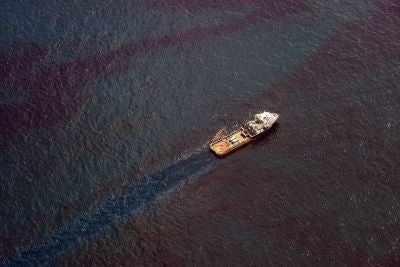Your support helps us to tell the story
From reproductive rights to climate change to Big Tech, The Independent is on the ground when the story is developing. Whether it's investigating the financials of Elon Musk's pro-Trump PAC or producing our latest documentary, 'The A Word', which shines a light on the American women fighting for reproductive rights, we know how important it is to parse out the facts from the messaging.
At such a critical moment in US history, we need reporters on the ground. Your donation allows us to keep sending journalists to speak to both sides of the story.
The Independent is trusted by Americans across the entire political spectrum. And unlike many other quality news outlets, we choose not to lock Americans out of our reporting and analysis with paywalls. We believe quality journalism should be available to everyone, paid for by those who can afford it.
Your support makes all the difference.As BP works to finally kill its runaway well and anxious coastal residents breathe a sigh of relief, experts warn it could take years - or even decades - for the Gulf of Mexico to recover.
Three weeks after the flow was fully stemmed with a temporary cap, the massive slick which once spread for hundreds of miles has been mostly dissolved or dispersed.
Nightmare scenarios in which tens of thousands of birds were smothered to death by blankets of oil proved unfounded after the bulk of the slick stayed offshore. Fishermen who feared their way of life was destroyed are being allowed back into most waters.
"There's essentially no skimmable oil left on the surface," Doug Suttles, BP's chief operating officer, told reporters Friday.
"Things have improved quite dramatically and that's a combination of the work we've done and Mother Nature."
But while Suttles appeared relieved that the well was finally plugged and should be officially "killed" in a matter of days, he cautioned that "we're far from finished."
Hundreds of miles of Louisiana's fragile coastal wetlands remain coated with sticky sludge and each tide carries fresh tar balls onto once-pristine beaches as far away as Florida.
Vast quantities of oil remain hidden below the waves, suspended in the water column in droplets which remain toxic to the fish and other marine life which once supported a multibillion dollar commercial and recreational fishing industry.
The good news is that the oil appears to be biodegrading rapidly.
The problem is that there is simply so very much out there.
It took 87 days to fully cap the well in the wake of a devastating explosion on April 20 that killed 11 workers and sank the BP-leased Deepwater Horizon rig, unleashing a torrent of oil into the Gulf.
In that time, 4.1 million barrels of oil escaped into the sea: enough to fill 260 Olympic-sized pools and make this one of the world's worst spills on record.
Just eight percent of the oil was removed from the sea by skimmers and controlled burns.
A government report issued last week estimates that another 42 percent is essentially "gone" thanks the heavy use of chemical dispersants and natural processes like evaporation and the microbes which feed on hydrocarbons.
"This whole notion that that stuff is weathering away is really questionable," said Jim Cowan, a professor in Louisiana State University's department of oceanography and coastal sciences.
"What dispersed oil does is eventually dissolves into sea water and the ultimate fate of that is ultimately undetermined."
Tarballs from the 1979 Ixtoc blowout are still washing up on Texas beaches. While the oil may float initially, it will sink once mixed with sand or sediment and then get kicked back up again during storms, he explained.
"What this has turned into now is the potential for a long term chronic problem," he said in a telephone interview.
"Chronic impacts are always more difficult to deal with from an ecosystem standpoint."
The toxic mix of oil and chemical dispersants could decimate fish populations by killing off vulnerable larvae and reducing the reproductively of those which survive.
"It's a race between the microbes eating it and everything else being exposed to it," said Larry McKinney, executive director of the Harte Research Institute for Gulf of Mexico Studies.
"Microbial action comes at a cost. They're organisms. They use oxygen."
The Gulf was already under stress from coastal erosion and a massive "dead zone" created when agricultural runoff from the Mississippi River feeds algae, which sucks the oxygen out of the water.
"We will likely have a pretty severe impact," McKinney told AFP, adding that the real concern is that the oil spill could be the final tipping point for an already stressed ecosystem.
"You can only be knocked down so many times before you can't get back up again."
Marine conservationist Rick Steiner, a retired University of Alaska scientist, said it's far too soon to hazard a guess at the true impact of the spill.
"What we're hearing is they don't think the damage will be as bad as they initially thought," Steiner said.
"We have to remember that the same thing was said after the Exxon Valdez. But much of the damage didn't become apparent until the second or third year."
Herring stocks have still not returned more than 20 years after the Valdez ran aground in Prince William Sound, Alaska. And oil is still seeping out of underground pockets on that rocky shore when it rains.

Join our commenting forum
Join thought-provoking conversations, follow other Independent readers and see their replies
Comments